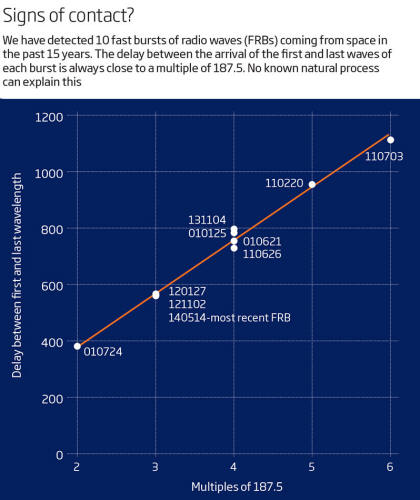|
Mysterious radio wave flashes from far outside the galaxy are proving tough for astronomers to explain. Is it pulsars? A spy satellite? Or an alien message?
BURSTS of radio waves flashing across the sky seem to follow a mathematical pattern.
If the pattern is real, either some strange celestial physics is going on, or the bursts are artificial, produced by human - or alien - technology.
Telescopes have been picking up so-called fast radio bursts (FRBs) since 2001. They last just a few milliseconds and erupt with about as much energy as the sun releases in a month.
Ten have been detected so far, most recently in 2014, when the Parkes Telescope in New South Wales, Australia, caught a burst in action for the first time.
The Parkes telescope: tuned in (Image: Roger Ressmeyer/Corbis)
The others were found by sifting through data after the bursts had arrived at Earth.
No one knows what causes them, but the brevity of the bursts means their source has to be small - hundreds of kilometers across at most - so they can't be from ordinary stars. And they seem to come from far outside the galaxy.
The weird part is that they all fit a pattern that doesn't match what we know about cosmic physics.
To calculate how far the bursts have come, astronomers use a concept called the dispersion measure.
Each burst covers a range of radio frequencies, as if the whole FM band were playing the same song. But electrons in space scatter and delay the radiation, so that higher frequency waves make it across space faster than lower frequency waves. The more space the signal crosses, the bigger the difference, or dispersion measure, between the arrival time of high and low frequencies - and the further the signal has travelled.
Michael Hippke of the Institute for Data Analysis in Neukirchen-Vluyn, Germany, and John Learned at the University of Hawaii in Manoa found that all 10 bursts' dispersion measures are multiples of a single number: 187.5 (see above chart).
This neat line-up, if taken at face value, would imply five sources for the bursts all at regularly spaced distances from Earth, billions of light-years away.
A more likely explanation, Hippke and Lerned say, is that the FRBs all come from somewhere much closer to home, from a group of objects within the Milky Way that naturally emit shorter-frequency radio waves after higher-frequency ones, with a delay that is a multiple of 187.5 (Discrete Steps in Dispersion Measures of Fast Radio Bursts).
They claim there is a 5 in 10,000 probability that the line-up is coincidence.
Cosmic objects might, by some natural but unknown process, produce dispersions in regular steps.
Small, dense remnant stars called pulsars are known to emit bursts of radio waves, though not in regular arrangements or with as much power as FRBs. But maybe superdense stars are mathematical oddities because of underlying physics we don't understand.
It's also possible that the telescopes are picking up evidence of human technology, like an unmapped spy satellite, masquerading as signals from deep space.
The most tantalizing possibility is that the source of the bursts might be a who, not a what. If none of the natural explanations pan out, their paper concludes,
Astronomers have long speculated that a mathematically clever message - broadcasts encoded with pi, or flashes that count out prime numbers, as sent by aliens in the film Contact - could give away aliens' existence.
Perhaps extraterrestrial civilizations are flagging us down with basic multiplication.
Power source
But a fast radio burst is definitely not the easiest message aliens could send.
As Maura McLaughlin of West Virginia University, who was part of the first FRB discovery points out, it takes a lot of energy to make a signal that spreads across lots of frequencies, instead of just a narrow one like a radio station. And if the bursts come from outside the galaxy, they would have to be incredibly energetic to get this far.
If the bursts actually come from inside the Milky Way, they need not be so energetic (just like a nearby flashlight can light up the ground but a distant light does not). Either way, though, it would require a lot of power.
In fact, the aliens would have to be from what SETI scientists call a Kardashev Type II civilization (see below "Keeping up with the Kardashevs").
But maybe there's no pattern at all, let alone one that aliens embedded.
There are only 10 bursts, and they fit into just five groups.
The pattern might disappear as more FRBs are detected.
Hippke and Learned plan to check their finding against new discoveries, and perhaps learn something about the universe.
If the result holds up, says Hippke,
Hippke is cautious, but notes that remote possibilities are still possibilities.
This article appeared in print under the headline "Cosmic radio plays an alien tune"
|


